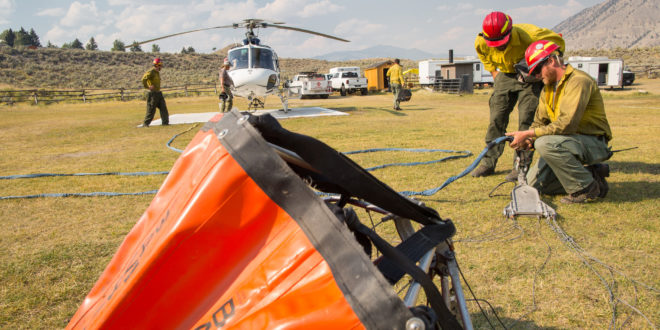The last official weekend of summer provided cold weather—rainy and very much welcomed by many in Yellowstone during this year’s fire season.
With large fires burning in the Park—including the Maple Fire near West Yellowstone and the Buffalo Fire near the Slough Creek campground northeast of Tower Junction, Sunday and Monday saw daytime temps in the 40s and 50s along with cold, steady rain in some areas.
But the rain also brought thunderstorms and more than 200 lightning strikes to the east Sunday, according to the Park’s official fire update Monday. The storm clouds darkened the sky to the east as viewed from Blacktail Plateau Drive, while the sun shone between clouds toward Mammoth Hot Springs.
Some hillsides just west of the Slough Creek turnoff were white Sunday afternoon, apparently from hail carried in one of the day’s thunderstorms.
Lightning strikes started at least two new fires. The Petrified Fire started near the Petrified Tree west of Tower Junction. With the help of helicopter fire drops, firefighters extinguished the single-tree fire, the Park reported. The Petrified Tree exhibit lies at the end of short one-way road not too far to the west of Tower Junction and Roosevelt Lodge. Being close to the road and frontcountry structures, the fire was located in a suppression zone.
The Jasper Fire, one-tenth of an acre, started east of Tower Junction near Specimen Ridge, and firefighters are monitoring this fire.
Whether a fire is “monitored” or “suppressed” depends on how close the fire is—or likely to get—to roads, developed area, or significant resources, Mike Johnson, a fire information officer with Yellowstone National Park said recently. Fires are managed through a “combination of monitoring and point-protection strategies,” the update said.
“We’ll take suppression action on areas of the fire where we need to,” Johnson said, which includes “point protection.”
“Point protection,” Johnson explained, means to extend fire protection to anything in the path of a fire that has “high-value risk.” For example, firefighters wrapped for protection some backcountry cabins and some seismic equipment in the path of the Maple Fire. Other high-value risks can include anything from critical habitat for an endangered species to a hydroelectric dam or a bald eagle’s nest, Johnson said.
The largest fire in the Park is the Maple Fire, which was reported as a lightning strike on Aug. 8. It’s burning near West Yellowstone, and trails accessible via the West Entrance Road are all closed as are the Mount Holmes trail and Purple Mountain. It’s reached more than 40,000 acres, prompting air-quality alerts for the West Yellowstone area.
The Maple fire is burning in the backcountry north and east of West Yellowstone in areas that were burned by the North Fork fire during the Park’s largest and most famous fire season back in 1988. The fires of ’88 affected about 1.1 million acres, according to information published by the National Park Service.
The Maple fire is burning through backcountry forests and meadows. Some areas burned in 1988 along the West Entrance Road, like the one-mile trail to Harlequin Lake, are now covered in thick regrowth of lodgepole pine. In the past 28 years, the lodgepoles have grown back 10 and 12 feet high and taller, so close together in spots as to be nearly impenetrable. The new trees grew up through soil covered in dead trees that were also burnt in ’88.
Fires that burn through previously burned areas can burn at a very high intensity, which might be due to the high fuel load of dead and fallen trees, according to the NPS, providing more opportunities for fire managers to study and understand fire behavior.
Despite the fires and smoky conditions, tourists continue to flock to Yellowstone. Gardiner, Montana bustled with visitors shopping and dining Sunday morning, with “No Vacancy” signs already on. A line of vehicles waiting to approach the North Entrance was backed up a couple hundred yards, inching forward patiently. Pronghorn antelope grazed nearby, mostly oblivious to the human traffic.
Park fires can continue to burn until a “season-ending weather event,” which is another way of saying “snow” or “a long spell of cold, steady rain.
The weather remained cool Monday, but warming temps and drier weather are predicted for later in the week, which could revive some hotspots in some fires, the Yellowstone fire report said.
 Yellowstone Insider Your Complete Guide to America's First National Park
Yellowstone Insider Your Complete Guide to America's First National Park





